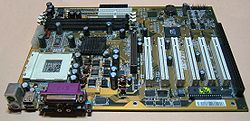
Selasa, 19 Februari 2008
Rabu, 13 Februari 2008
Motherboard
PC motherboard
From Wikipedia, the free encyclopedia
| All or part of this article may be confusing or unclear. Please help clarify the article. Suggestions may be on the talk page. (March 2007) |
| Motherboard | |
 The ASUS CUSL2-C motherboard | |
Connects to:
| |
| Form factors: | |
| Common Manufacturers: |
A PC motherboard is a printed circuit board used in laptops and personal computers. It is also known as the mainboard or planar board and occasionally abbreviated to mobo or MB. The term mainboard is also used for the main circuit board in this and other electronic devices.
A typical motherboard provides attachment points for one or more of the following: CPU, graphics card, sound card, hard disk controller, memory (RAM), and external peripheral devices. The connectors for external peripherals are nearly always color coded according to the PC 99 specification.
All of the basic circuitry and components required for a computer to function are onboard the motherboard or are connected with a cable. The most important component on a motherboard is the chipset. It often consists of two components or chips known as the Northbridge and Southbridge, though they may also be integrated into a single component. These chips determine, to an extent, the features and capabilities of the motherboard.
Contents[hide] |
[edit] CPU sockets
- Main article: CPU socket
[edit] Peripheral card slots
A typical motherboard of 2007 will have a different number of connections depending on its standard. A standard ATX motherboard will typically have 1x PCI-E 16x connection for a graphics card, 2x PCI slots for various expansion cards and 1x PCI-E 1x which will eventually supersede PCI.
A standard Super ATX motherboard will have 1x PCI-E 16x connection for a graphics card. It will also have a varying number of PCI and PCI-E 1x slots. It can sometimes also have a PCI-E 4x slot. This varies between brands and models.
Some motherboards have 2x PCI-E 16x slots to allow more than 2 monitors without special hardware or to allow use of a special graphics technology called SLI (for Nvidia) and Crossfire (for ATI). These allow 2 graphics cards to be linked together to allow better performance in intensive graphical computing tasks such as gaming and video editing.
As of 2007, virtually all motherboards come with at least 4x USB ports on the rear with at least 2 connections on the board internally for wiring additional front ports that are built into the computers case. Ethernet is also included now. This is a standard networking cable for connecting the computer to a network or a modem. A sound chip is always included on the motherboard to allow sound to be output without the need for any extra components. This allows computers to be far more multimedia based than before. Cheaper machines now often have their graphics chip built into the motherboard rather than a separate card.
[edit] Nvidia SLI and ATI Crossfire
Nvidia SLI and ATI Crossfire technology allows 2 of the same series graphics cards to be linked together to allow a faster graphics experience. Almost all medium to high end Nvidia cards and most high end ATI cards support the technology.
They both require compatible motherboards. There is an obvious need for 2x PCI-E 16x slots to allow 2 cards to be inserted into the computer. ATI opened the technology up to Intel in 2006 and such all new Intel chipsets support Crossfire.
SLI is a little more proprietary in its needs. It requires a motherboard with Nvidia's own NForce chipset series to allow it to run.
Although this might seem like a great idea, it is important to note that SLI and Crossfire only offer up to 1.5x the performance of a single card. They also do not double the effective of amount of Vram.

